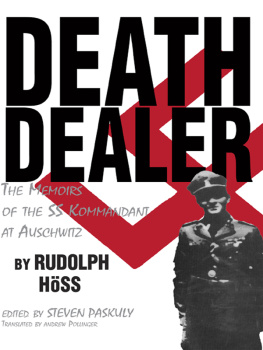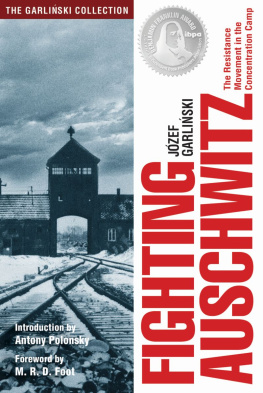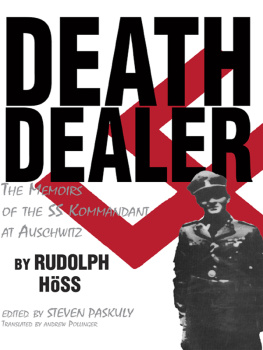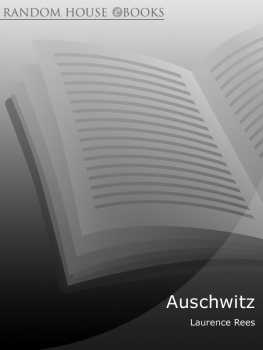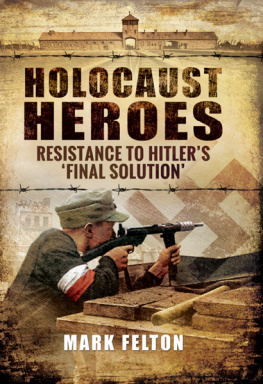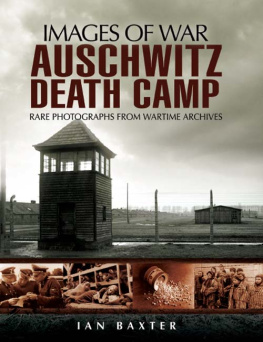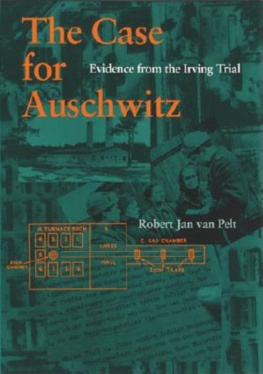
It is with the deepest gratitude that I thank the following for their help and encouragement throughout the eleven years it took to finish this book. I thank my wife Carol, our son Stephen, our daughter Laura, my good friend Andrew Pollinger and his wife Rita Pollinger, His Excellency Cardinal Glemp of Poland, Director of the Auschwitz Museum Kazimierz Smolen, Terese Swiebocka, Yolanta Hepworth, Professor Dr. Czeslaw Pilichowski, Mieczyslaw Koscielniak, Maria Bukowska, Mrs. Motyl and Adamska, Dr. Zofia Federowska, Leokadia Kotodynska, Dr. Franciszek Piper, Mr. Joseph Odi, Wladyslaw Dudzic, Jerzy Piatkowski, Vera T. Kowalski, Joseph Szustakowski, Andrea Schuessler, Ann Szczesny, Jessie Goralski, Dr. E. M. Schulman, Professor Dr. Leslie Fiedler, Professor John Nash, William Kessel, Professor R. Alan Hughes, Claire Levi, Gerda Klein, James Benson, Dow Chemical Inc., Nancy Pfalzer-Muffoletto, Janet Ketelsen, Marjorie Torrell, Susan Catlin, Edna M. Rogger, Evelyn Williamson, Dr. Joseph Shanahan, Samuel Alessi, with special thanks to Lynn Hochworter, Daniel Manes, Mark Costa, who drew the diagrams, and to all my colleagues, family, friends, and especially to my students, who kept after me to finish this book by asking almost every day, Is it finished yet?

Budy was a poor village about four kilometers from the main camp at Auschwitz. For the most part it was uninhabited because the Poles had either been deported to other areas or were in concentration camps. A subcamp of women prisoners was established there to house those prisoners who would work in the fields. A schoolhouse and a large wooden building were used as the living quarters for the prisoners. A single barbed wire fence surrounded the living quarters, and even at night the lighting was not particularly bright, which tended to indicate that the prisoners were not especially dangerous. The ground floor was occupied by the block seniors and the camp seniors, which were composed of German citizens and former prostitutes from Germany. The kitchen and the infirmary was also located on the same floor. Several German women prisoners who had special duties in the camp and a considerable number of Jewish women slept in the attic, which had two windows. The majority, however, lived in the wooden building. There were three hundred to four hundred Jewish, Ukrainian, and Polish women housed there.
In the morning hours of October 6,1942, a criminal investigator named Wosnitza and two clerks were ordered to quickly pack up their typewriters and writing materials and get into the waiting car in front of the Kommandant's office. [SS Lieutenant] Grabner [of the camp Gestapo] was already in the car waiting for the three men. The men realized that something terrible had happened by the dour expression on Grabner's face and the hints he revealed about a revolt at Budy.
As they passed by the sentries who were guarding the area that was now closed off to all personnel except for the investigation team, they heard a strange buzzing and humming in the air. As they moved toward the sound, they witnessed a sight so horrible that what they were seeing did not immediately register in their minds. The area next to and behind the school was covered with dozens of mutilated and bloody female corpses lying all over. All the women were wearing only old undergarments. Half-dead women were twisting in pain among the dead bodies. Their groaning added to the humming sound of the enormous swarms of flies which circled around the sticky pools of blood and the smashed skulls, revealing the source of the strange sound. Some of the corpses hung in twisted positions in the barbed wire fence. Others evidently seemed to have been thrown from the upper windows, which were still open.
Grabner ordered the investigators to question the women lying on the ground, but Wosnitza could not find anyone who was in any condition to talk, so he began questioning some of the women who were less seriously injured as they washed their wounds at the nearby well.
The SS soldiers who were guards at the camp were in the habit of encouraging the German prisoners to mistreat the Jewish women. If they refused, they themselves were threatened with being forced to run through the chain of guards and shot while attempting to escape. This was their idea of fun to fill in the boring duty of guarding prisoners. The German women were paranoid that the Jewish women would somehow try to get even. The Jewish women prisoners were for the most part well-educated. Some had attended the famous Sorbonne University in Paris, and some were artists, who never even thought of stooping to the low-class level of the German prostitutes or of even planning revenge.
On the evening of October 5, a Jewish prisoner was going up the stairs, returning to her sleeping quarters from the lavatory. A German woman saw her and thought she was holding a stone in her hand. The SS guard outside at the gate was the German prostitute's lover. She leaned out of the window and cried to the SS guard for help, saying that she had been hit by the Jewish woman.
All the SS guards on duty immediately ran upstairs and began beating the Jewish women at random. They got so carried away that they threw some women down the winding staircase, so that they fell on each other in a heap at the bottom. Some were even thrown out of the windows, where they fell to their death. The guards then drove the Jewish women into the yard. The German woman who had started the butchering stayed in the bedroom with her lover. The revolt was put down with clubs, gun butts, and shootings. One of the female Kapos even used an axe on the terrified Jews. The women were now in a fearful panic as they tried to escape the bloodshed. Some tried to crawl under the barbed wire where they got stuck and were brutally killed on the spot. Even when all the women lay helpless on the ground, the fiends, drunk with bloodlust, kept on beating the helpless victims. It seems they wanted to kill everybody in order to destroy all the witnesses.
At about 5 a.m., Kommandant Hss was notified of the revolt. He arrived at Budy and inspected the site of the bloody orgy. A few wounded women who had hidden among the corpses revealed themselves because they thought that they were saved, since the Kommandant himself was there. Hss soon left the camp after a brief inspection. As soon as he left, the wounded women were shot to death.
The SS investigators and SS medical orderlies were there the next morning to give medical help to the injured. Some of the less seriously wounded who had not revealed their hiding places as early as the others came forward to be treated. The investigators, acting on orders, took many photographs of the bloodbath. Under strict supervision, only one copy of each photo was printed. The negative plates were destroyed in the presence of Kommandant Hss.
One after another, the injured women were taken to an empty room and given phenol injections into the heart. The patients died in seconds. An elderly Jehovah's Witness, who had been in concentration camps for years, looked on with the other women prisoners as the half-dead, as well as the living, were pushed through one doorway while the corpses were carried out the other and thrown onto wooden carts.
Six German women who had participated in varying degrees in the slaughter were taken to Block 11 in Auschwitz, along with the Axe Queen Elfriede Schmidt, who was the favorite of the SS butchers. After the interrogations were completed and their confessions were duly acknowledged, they lay peacefully silent forever. Just a small red dot under the left breast indicated the cause of death. Their parents received the usual properly worded note of condolence from the Kommandant, which informed them that their daughters had died in spite of the best medical treatment and care.
Next page
